Drake European Tour

Canadian hitmaker and award-winning R&B superstar Drake is on the road in Europe with lighting, video and rigging supplied out of PRG’s UK base in Longbridge, Birmingham, working closely with USA counterparts, PRG North America, in an impressive intercontinental collaboration to ensure the artist’s production enjoys full continuity and technical integration wherever in the world the show is playing.
The European tour started immediately after this year’s Wireless Festival, staged in London’s Finsbury Park, where Drake became the first artist to headline each night of the 3-day event, performing different setlists and with a selection of other artists across the three days, utilising a super-sized version of his touring lighting rig.
PRG UK also supplied lighting and rigging for this event, which was a seriously scaled up version of this original touring show concept. The first and second legs took North America and Australia by storm earlier in the year.
Creative Originality
Guy Pavelo likes to keep busy, and on this tour is the lighting designer alongside John Torres. He is also the production designer and took on the demanding technical director role plus co-ordinating the show operations.
Guy has worked with Drake’s team for the last 15 years, and for this “Some Special Songs for EU” (SSS4EU) leg of the tour, he collaborated with Drake’s creative director, Matte Babel, show manager Steve Kidd and Drake’s manager Future on the show design.

The concept of two ‘bare’ stages connected into a 360 environment by elevated transparent acrylic walkways running around both sides of the arena – with the audience on all sides and in the middle – gives the artist maximum proximity to his fans, and started germinating last year.
“He basically wanted it to have this proper nightclub vibe in the room,” explained Guy. This ambitious staging design facilitates that aesthetic, complete with a kinetic ceiling above the audience that is full of lighting and automated trussing pieces: “It basically gives the means to create the intimacy and mood of an immersive club experience with the crowd very much included as part of the action.”
With a large automated lighting rig overhead, light sources – which also move – can glide in and completely transform the shape and architecture of the space above the audience’s heads.
Nightclub Vibes
All the classic positive psychological plays on light become unlocked and available and these cavernous spaces bathed in light and movement are transformed for the performance, which recreates that intimate, intense and very subjective clubby atmosphere.
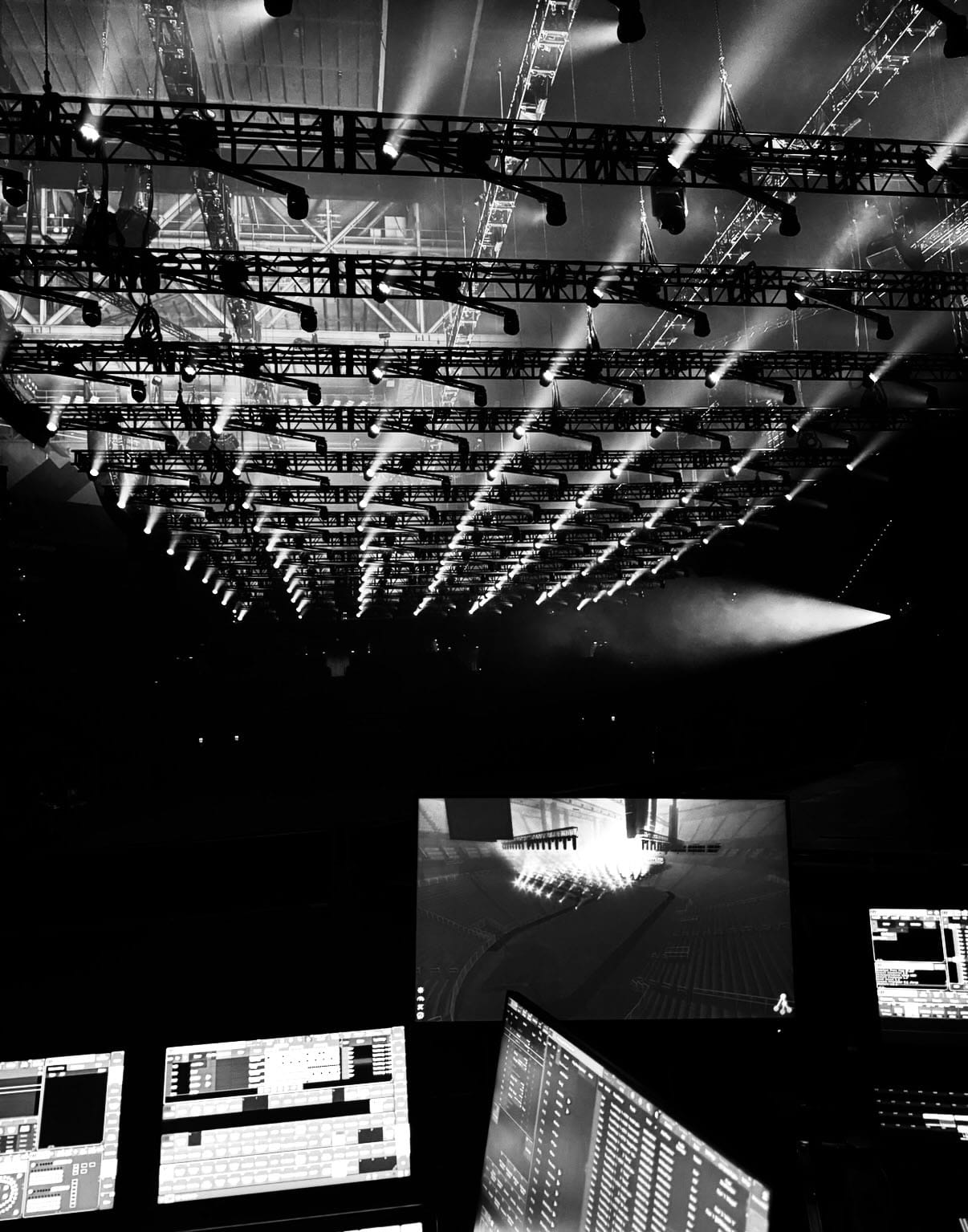
As a visual concept, this scenography is a perfect backdrop for Drake’s very individual style of performance delivery.
They initially tried this format in Australia at the start of the tour, noted Guy, where it was a massive success, so everyone worked on moving it forward from there.
It was a bold move in terms of visuality, having the two stripped-back stages at each end of the room, with open space and maximum viewing angles where more conventional designs might normally have the comfort of stage and production infrastructure.
Apart from being refreshingly different, this ideal show playground for Drake, well known for having a special and very personal connection to his fans, presented some great challenges for production, one of which was keeping all the technical infrastructure extremely neat, tidy and hidden from view.
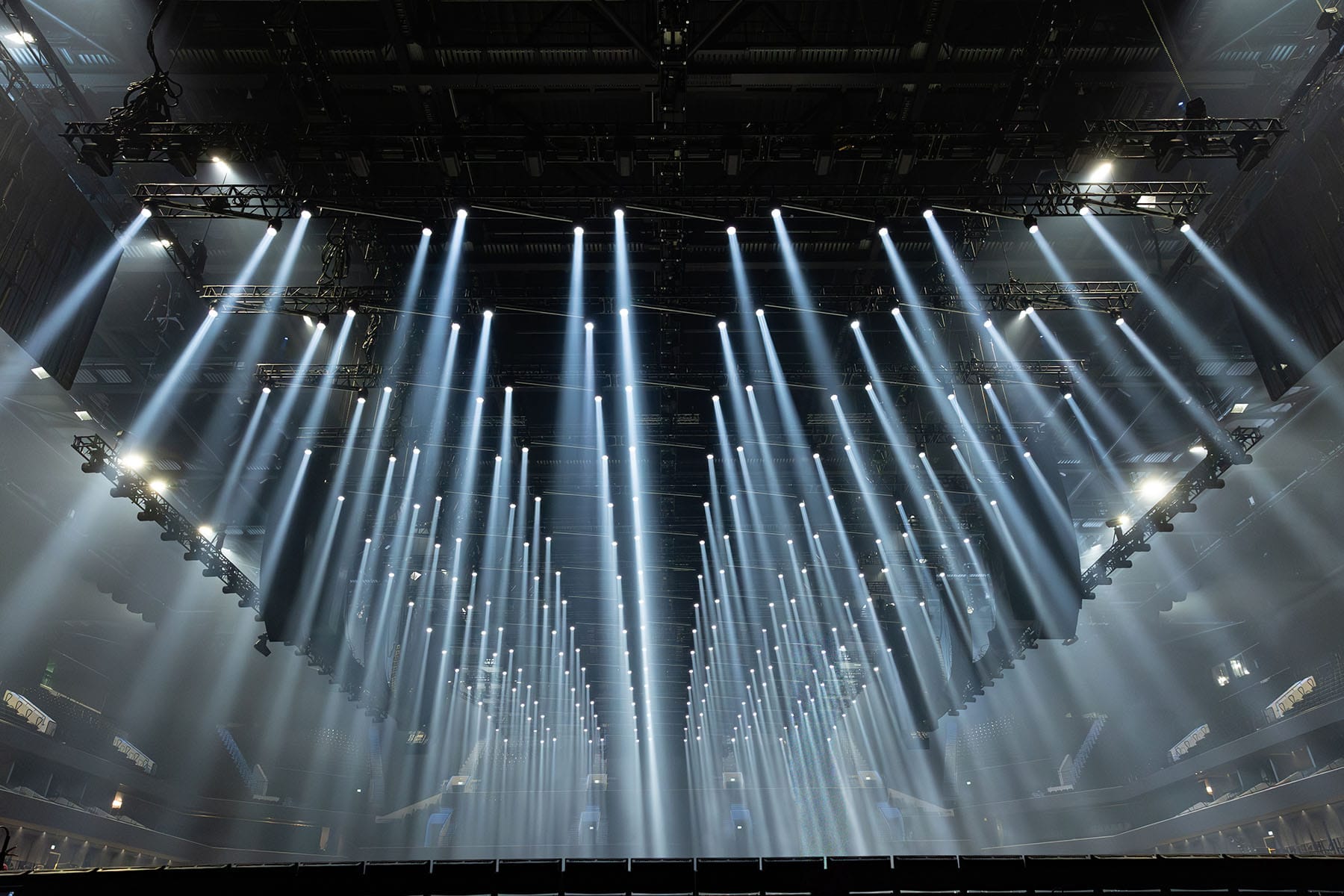
Hanging below a large 180ft x 50ft mothergrid comprising 6 x 80ft spans, three wide and two deep, the lighting rig over the arena is hung on 16 x 70 ft long pre-rigged trusses, which were specially modified by PRG.
Each of these is fitted with 7 x 10 ft sections of spinning truss attached to Claypaky Panify 2 motorised platforms, which have also been customised by PRG’s workshop to be tourable.
The Spin of Lighting
Each of these 112 ‘spinners’ in turn is rigged with 2 lengths of Martin VDO Sceptron linear strips and 2 x GLP impression X5 Compact moving lights, giving 1180 fixtures on this kinetic and highly dynamic part of the rig.
The 16 x 70ft trusses are each flown on 3 x TAIT 1-ton NAV hoists and move in and out of the arena space in a variety of configurations, sometimes so the lights are barely skimming heads, creating a hugely exciting and very dynamic environment.
Operating the TAIT Navigator system is Sydney Rush with cues being worked out and developed between her, Guy, John and Matte. Navigator programming was initially handled by TAIT’s Doug Sager.
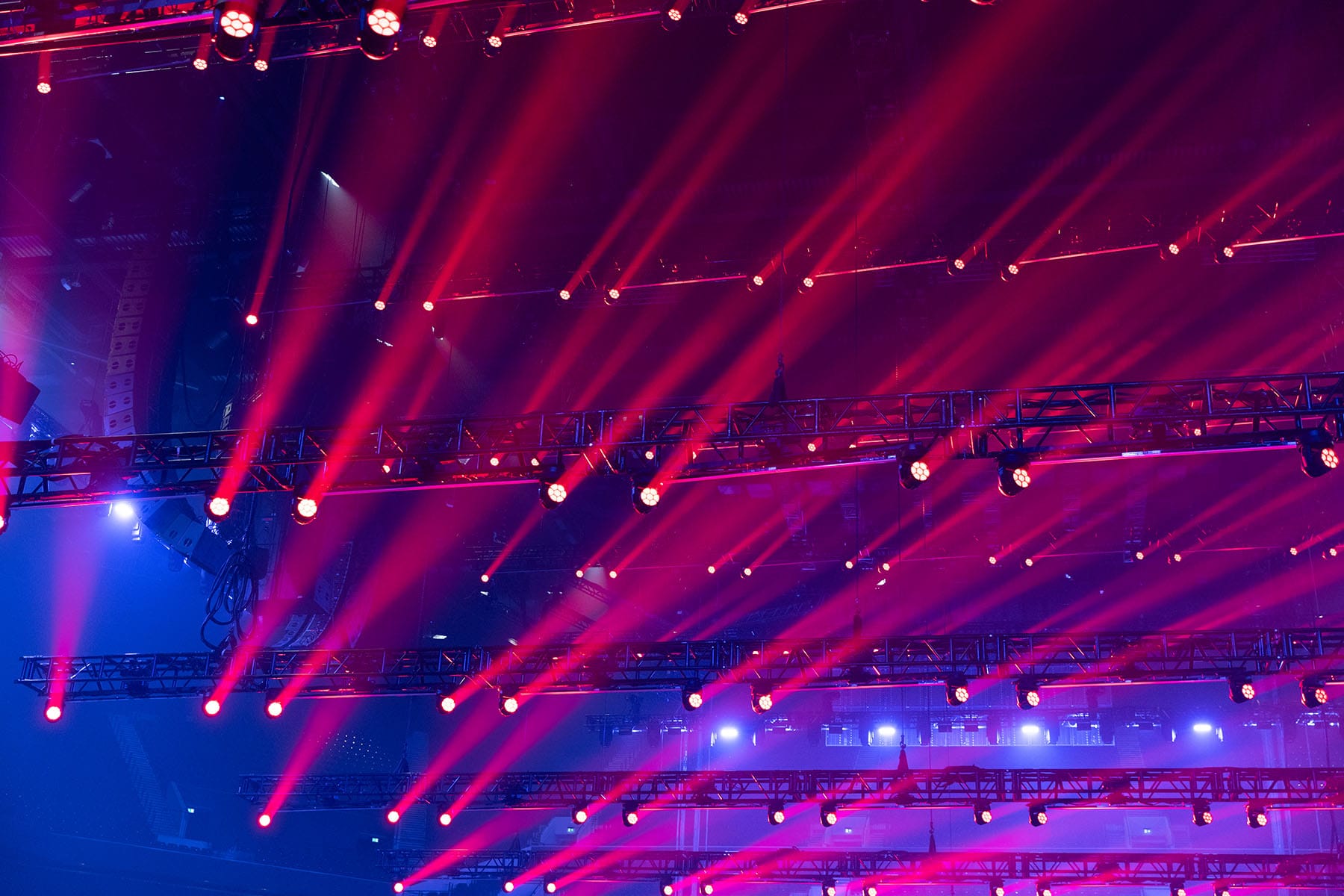
The ‘spinners’ are controlled together with all the lights via Guy’s grandMA3 console – and when they start doing their tricks – a whole new layer of automation is revealed to the delight of audiences!
The movement is a major defining hallmark of this show, and gives rise to all sorts of shapes, angles and offsets, sometimes moving imperceptibly, and other times very dramatically, all the time allowing Drake’s stagecraft to remain the centre of attention.
A Bit Flash!
Up in the mothergrid, 64 x JDC1 strobes are scattered around and depending on the height and position of the 16 moving trusses, these can also have very dramatically different looks and effects.
In addition to the above arena lighting are four audience trusses, one running along each side of the arena outside of the central grid area, two at 100ft long and two at 70ft, and these are rigged with a total of 68 x Ayrton Veloce moving lights, alternated on each truss with 13 x JDC1s.
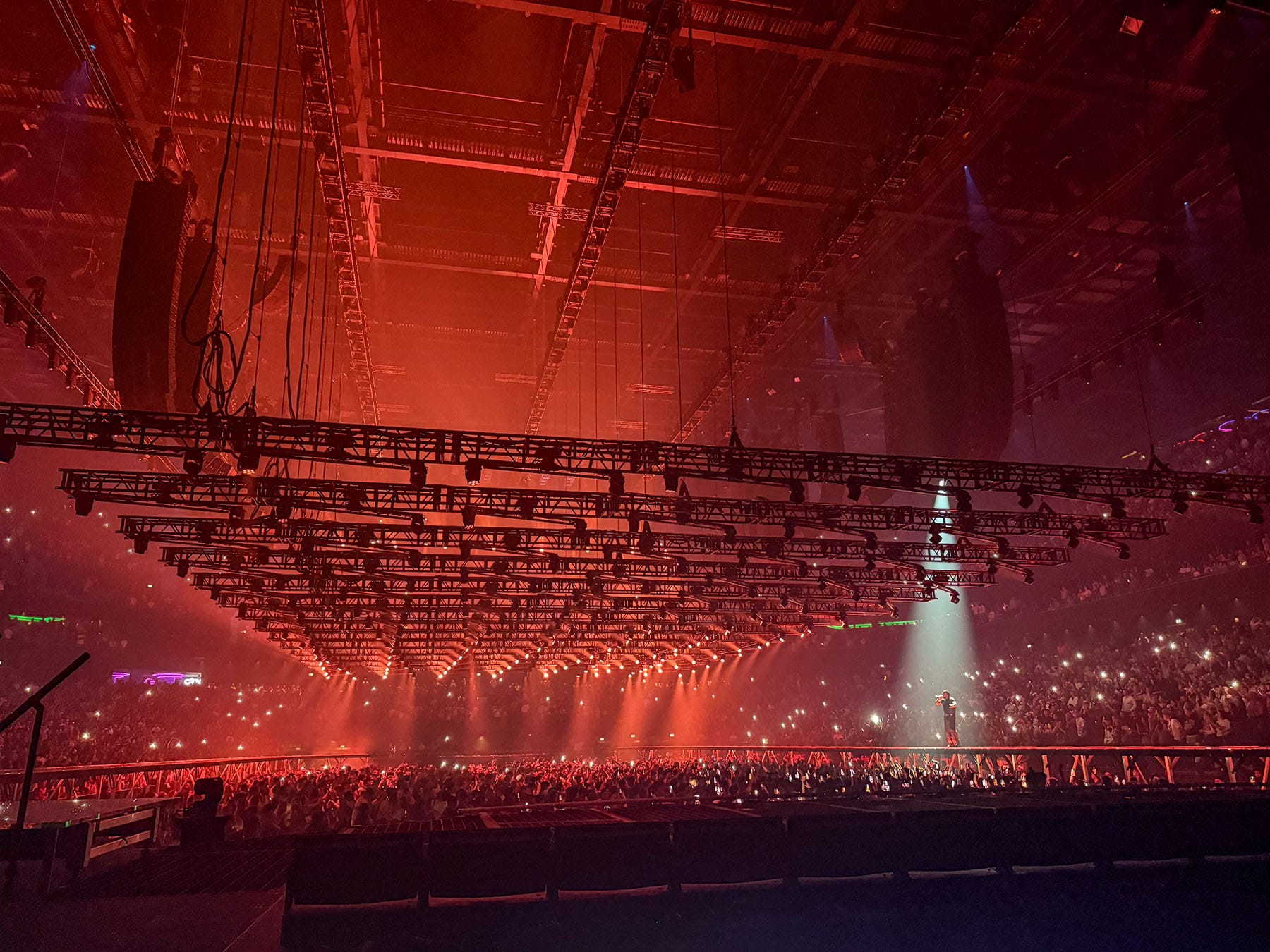
The Veloces – a new investment by PRG UK – are in the perfect location for hitting positions all along the runways and on the stages.
Also in the mothergrid are two follow spots, with another two positioned on the long side audience trusses, plus another four in the audience bleacher seating – all of them run via PRG’s ground control remote follow spotting solution, with the operators tucked away backstage.
Bare Stages
The stages at either end of the arena directly mirror each other. Both feature grilled surfaces with a sub-deck one metre below that is loaded with 62 x JDC1 strobes for some impressive flash-through effects!
The balance of the lighting is ensconced into the floor level of both stages, with a bank of 25 x JDC1 Bursts at the back, 22 x GLP Impression FR10 LED Bars in two lines – in front and to the rear – with 10 Astera Titan Tubes around the front lip of the stage.
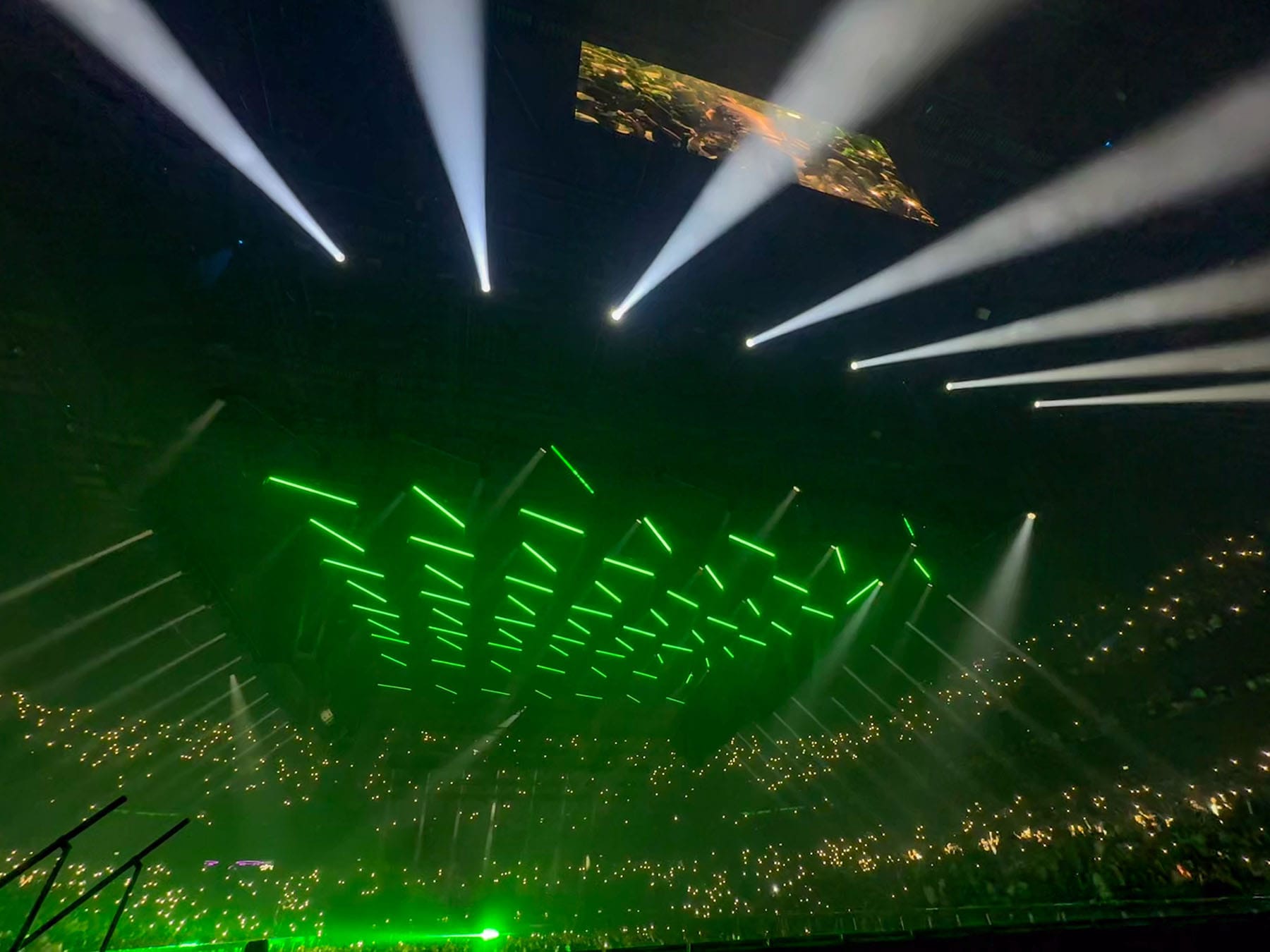
All of these lights are meticulously positioned in the design to retain the clean lines, raw and open appearance of the stage, again giving fans the best possible views of Drake who utilises the entire set extensively throughout every show, playing directly to as much of the arena as possible, and this whole scenographic creation is geared to enabling him to achieve this.
Illuminating the runway – scalable in length according to the venue – are around 200 Astera Titan Tubes which are clamped into custom brackets below the special decking, built by TAIT.
The Titans – chosen for practicality, robustness and max neatness – are charged in their cases during the afternoon, then clamped into the custom brackets beneath the runway sections and run wirelessly for the show, all controlled by Guy’s grandMA3.
In Control
Two hundred universes of lighting data are running back to Guy’s grandMA3 full size console on which he is running the show. He’s been running grandMA3 since it was first available, so it was naturally a first choice, and also enables him to seamlessly control the video feeds. Guy is someone who sees the bigger picture all the time and it is essential to his role to have these major elements under his control.
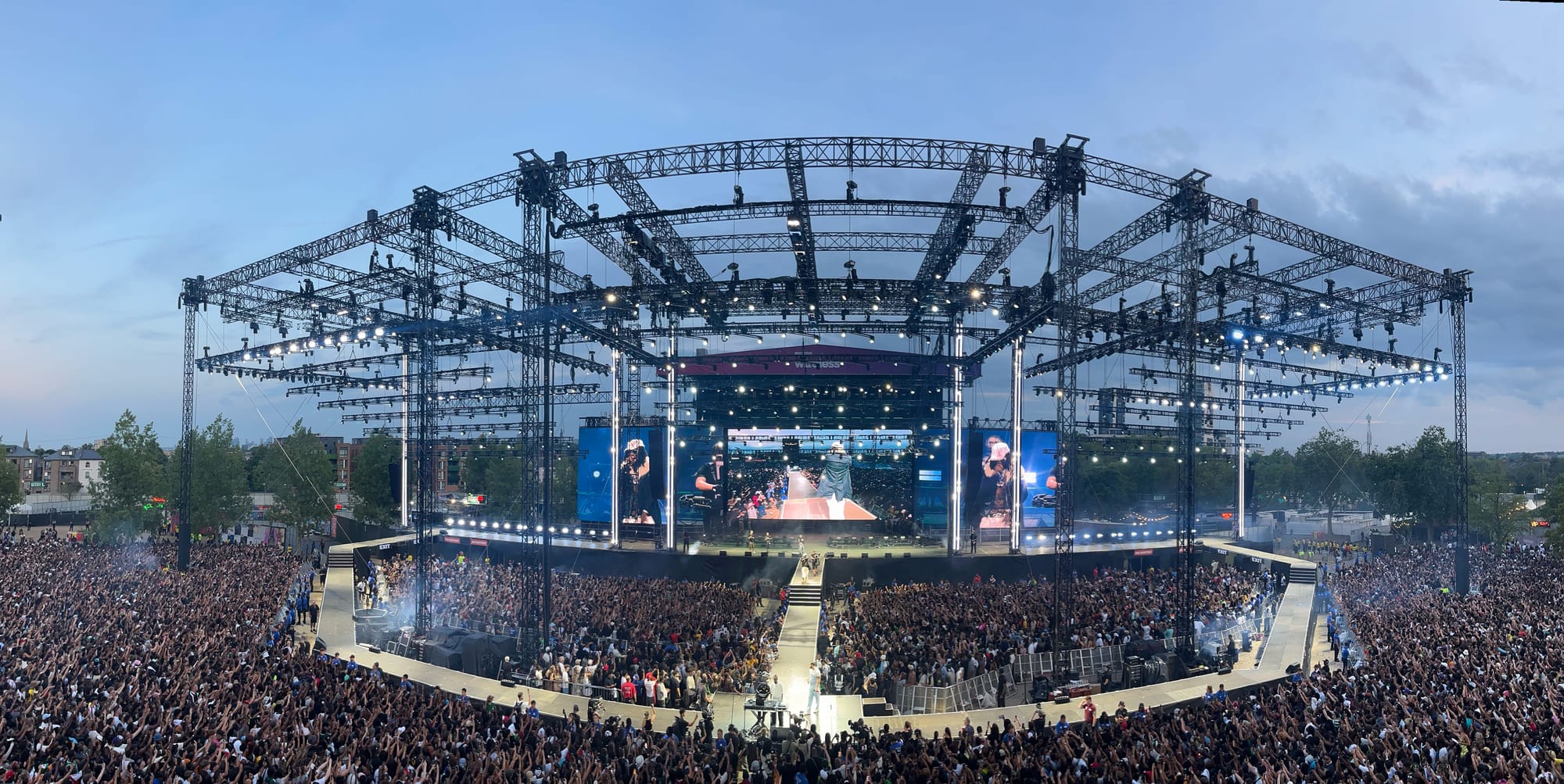
Assisting in ramping up the clubby vibes are 8 x strategically positioned MDG theONE hazers and fans. Hazers and fog management on a big open plan arena show like this is an art in its own right.
Lighting equipment and a crew of 14 are being co-ordinated and overseen on the road by lighting crew chief, the unflappable Ronnie Beal from PRG North America, who was involved in some intensive pre-prepping for the various lighting elements at PRG UK’s Longbridge HQ before hitting the road in Europe.
He enjoyed the “fantastic support from the UK team,” which is project managed by Yvonne Donnelly and her team at PRG Longbridge in conjunction with Jon Morrell from the LA base of PRG North America.
Video Moments
Video was required to work slightly differently – but equally as importantly – as a visual medium in this design in a departure from the standard screen-on-stage scenario.
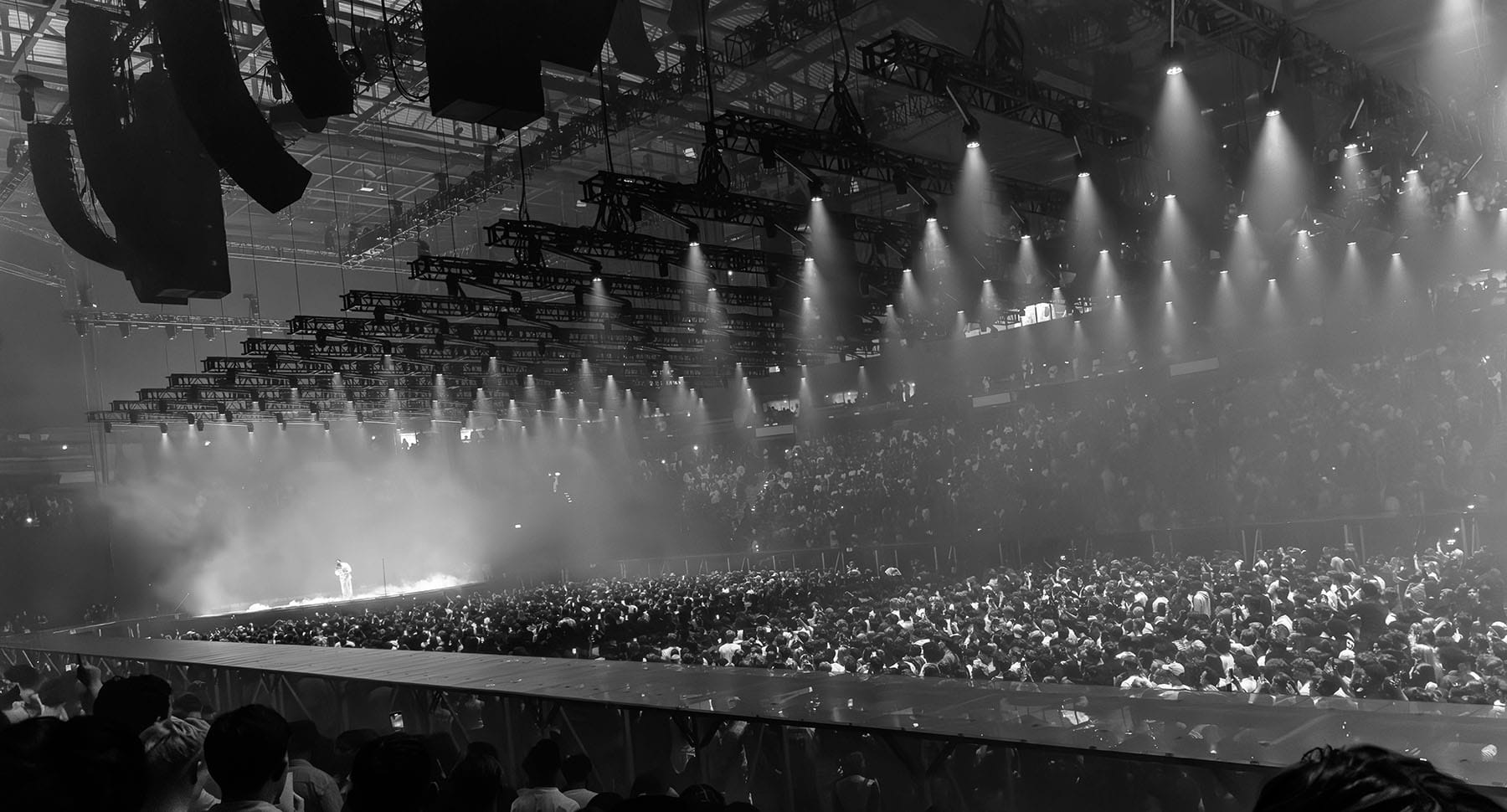
With Drake’s desire to be as close as possible to the audience, the six IMAG screens are designed and positioned to ensure exactly that – keep the sightlines clean while ensuring that everyone there enjoys a great view of the artist.
Weaving all the magic together live onscreen is award-winning camera director Colleen Wittenberg, who picked up the coveted 2024 Total Production (TPi) Award for Video Specialist of the Year. She is a freelance video director based in Nashville, Tennessee, who joined the production – via PRG – for Wireless and continues on the SSS4EU leg of the tour.
Her mix comprises feeds from four operated Grass Valley LDX 135 cameras fitted with 99x zoom long lenses – sports event style – and positioned at the lower mezzanine levels on all four sides of the venue, plus an LDX 86c on a Steadicam rig fitted with a 24x zoom lens for extra depth.
In addition to these are four Panasonic PTZ 150 and two PTZ 130 robo cams. The 150s are set up in a zig zagged pattern downstage on both of the stages, while the 130s are used for the DJ section of the show, where Drake plays a DJ set up – typically – located in the bleachers along one of the venue ‘long sides’ for which a physically smaller camera was specified.
The second PTZ 130 also provides a wide ‘architectural’ cross-shot looking at the whole venue, capturing the structural elements of the automated lighting rig as it moves into different patterns.
SSS4EU is Colleen’s first 360 video direction touring project, a challenging environment enough itself, but one that she has embraced with great enthusiasm.
With all the video emphasis on IMAG, Colleen’s task is a complex one to enhance the show narrative, underline a good story, ensure Drake is visible at all times and that his considerable energy levels are communicated onscreen and in sync with what is happening in the room.
Quick Thinking
This entails plenty of quick thinking and ability to imagine full vistas instantly i.e. how her mix will appear in the context of the greater overall show.
For this, she is using a Grass Valley Karrera 2M/E switcher. Both M/E buses plus two Auxs are used in the show. Colleen works closely with her two engineers, Randy Ice and Braxton Carico, together with 8 others on the video crew. These include Colin Mudd, video crew chief for PRG UK, who is also entertaining the whole crew with his acerbic wit in addition to running the video operation!
As a performer, Drake is very organic, so while there is a structure and a setlist, there is also contingency for improv, which happens constantly, making every show completely unique.
Colleen’s mix is fed into 6 x PRG M-Box video servers (3 live and 3 hot backup) and output to screens by Guy triggered via his grandMA3 system. The M-Boxes are running V5 software version, and are the first rental units to do so, which Guy is happy to report are “solid”.
Colleen is enjoying working with the PRG UK team, who she observes are “very responsive whenever anything is needed, or dealing with last minute replacement requests or any issues that require solving at the vendor level, which is essential when moving through multiple countries”.
The Wireless Challenge
For PRG UK’s project manager Yvonne Donnelly, while building and co-ordinating the tour was intense, the biggest challenge without doubt was replicating this lighting rig and unique aesthetic at Wireless Festival, which was essentially the first gig of the SSS4EU leg.
Working at the Finsbury Park site was very different to staging an indoor show and the scale substantially larger than the touring show. The 360 look was achieved using three ground support systems and a huge amount of calculation, calibration and teamwork to safely build a system to accommodate the amount of dynamic loading needed for this show with all its moving elements.
All this was done in just three days involving up to 140 combined Wireless and touring PRG crew.
Yvonne has worked closely with her counterpart in PRG North America, Jon Morrell, throughout the project.
“We all enjoy challenges, and the incredible teamwork and determination enabling us to deliver the full Drake experience for fans at Wireless was truly inspiring,” she concluded.
The tour schedule is tight with several back-to-backs and only a few days off over a 10-week period. Keeping everything rolling smoothly on the road in Europe is production manager Joseph Lloyd and 32 trucks, three of which are carrying duplicated elements of the stage and rigging that are being leap-frogged to ensure maximum efficiency and achievability given the timescale. Audio is being supplied by Clair Global.
Aaron Siebert was the production manager for the earlier Australian leg of the tour, for which all the lighting and video kit was flown from PRG North America, illustrating the global reach and capacity of its operation. Paul Lovell-Butt PM’d the previous North American leg, and also Australia, together with Aaron. Aaron has now returned to his role at TAIT and Josef will production manage the tour from now until it concludes and returns to the USA.
PRG Provides SSS4EU Drake Tour
Canadian hitmaker and award-winning R&B superstar Drake is on the road in Europe with lighting, video and rigging supplied out of PRG’s UK base in Longbridge, Birmingham, working closely with USA counterparts, PRG North America, in an impressive intercontinental collaboration to ensure the artist’s production enjoys full continuity and technical integration wherever in the world the show is playing.
The European tour started immediately after this year’s Wireless Festival, staged in London’s Finsbury Park, where Drake became the first artist to headline each night of the 3-day event, performing different setlists and with a selection of other artists across the three days, utilising a super-sized version of his touring lighting rig.
PRG UK also supplied lighting and rigging for this event, which was a seriously scaled up version of this original touring show concept. The first and second legs took North America and Australia by storm earlier in the year.
Creative Originality
Guy Pavelo likes to keep busy, and on this tour is the lighting designer alongside John Torres. He is also the production designer and took on the demanding technical director role plus co-ordinating the show operations.
Guy has worked with Drake’s team for the last 15 years, and for this “Some Special Songs for EU” (SSS4EU) leg of the tour, he collaborated with Drake’s creative director, Matte Babel, show manager Steve Kidd and Drake’s manager Future on the show design.
The concept of two ‘bare’ stages connected into a 360 environment by elevated transparent acrylic walkways running around both sides of the arena – with the audience on all sides and in the middle – gives the artist maximum proximity to his fans, and started germinating last year.
“He basically wanted it to have this proper nightclub vibe in the room,” explained Guy. This ambitious staging design facilitates that aesthetic, complete with a kinetic ceiling above the audience that is full of lighting and automated trussing pieces: “It basically gives the means to create the intimacy and mood of an immersive club experience with the crowd very much included as part of the action.”
With a large automated lighting rig overhead, light sources – which also move – can glide in and completely transform the shape and architecture of the space above the audience’s heads.
Nightclub Vibes
All the classic positive psychological plays on light become unlocked and available and these cavernous spaces bathed in light and movement are transformed for the performance, which recreates that intimate, intense and very subjective clubby atmosphere.
As a visual concept, this scenography is a perfect backdrop for Drake’s very individual style of performance delivery.
They initially tried this format in Australia at the start of the tour, noted Guy, where it was a massive success, so everyone worked on moving it forward from there.
It was a bold move in terms of visuality, having the two stripped-back stages at each end of the room, with open space and maximum viewing angles where more conventional designs might normally have the comfort of stage and production infrastructure.
Apart from being refreshingly different, this ideal show playground for Drake, well known for having a special and very personal connection to his fans, presented some great challenges for production, one of which was keeping all the technical infrastructure extremely neat, tidy and hidden from view.
Hanging below a large 180ft x 50ft mothergrid comprising 6 x 80ft spans, three wide and two deep, the lighting rig over the arena is hung on 16 x 70 ft long pre-rigged trusses, which were specially modified by PRG.
Each of these is fitted with 7 x 10 ft sections of spinning truss attached to Claypaky Panify 2 motorised platforms, which have also been customised by PRG’s workshop to be tourable.
The Spin of Lighting
Each of these 112 ‘spinners’ in turn is rigged with 2 lengths of Martin VDO Sceptron linear strips and 2 x GLP impression X5 Compact moving lights, giving 1180 fixtures on this kinetic and highly dynamic part of the rig.
The 16 x 70ft trusses are each flown on 3 x TAIT 1-ton NAV hoists and move in and out of the arena space in a variety of configurations, sometimes so the lights are barely skimming heads, creating a hugely exciting and very dynamic environment.
Operating the TAIT Navigator system is Sydney Rush with cues being worked out and developed between her, Guy, John and Matte. Navigator programming was initially handled by TAIT’s Doug Sager.
The ‘spinners’ are controlled together with all the lights via Guy’s grandMA3 console – and when they start doing their tricks – a whole new layer of automation is revealed to the delight of audiences!
The movement is a major defining hallmark of this show, and gives rise to all sorts of shapes, angles and offsets, sometimes moving imperceptibly, and other times very dramatically, all the time allowing Drake’s stagecraft to remain the centre of attention.
A Bit Flash!
Up in the mothergrid, 64 x JDC1 strobes are scattered around and depending on the height and position of the 16 moving trusses, these can also have very dramatically different looks and effects.
In addition to the above arena lighting are four audience trusses, one running along each side of the arena outside of the central grid area, two at 100ft long and two at 70ft, and these are rigged with a total of 68 x Ayrton Veloce moving lights, alternated on each truss with 13 x JDC1s.
The Veloces – a new investment by PRG UK – are in the perfect location for hitting positions all along the runways and on the stages.
Also in the mothergrid are two follow spots, with another two positioned on the long side audience trusses, plus another four in the audience bleacher seating – all of them run via PRG’s ground control remote follow spotting solution, with the operators tucked away backstage.
Bare Stages
The stages at either end of the arena directly mirror each other. Both feature grilled surfaces with a sub-deck one metre below that is loaded with 62 x JDC1 strobes for some impressive flash-through effects!
The balance of the lighting is ensconced into the floor level of both stages, with a bank of 25 x JDC1 Bursts at the back, 22 x GLP Impression FR10 LED Bars in two lines – in front and to the rear – with 10 Astera Titan Tubes around the front lip of the stage.
All of these lights are meticulously positioned in the design to retain the clean lines, raw and open appearance of the stage, again giving fans the best possible views of Drake who utilises the entire set extensively throughout every show, playing directly to as much of the arena as possible, and this whole scenographic creation is geared to enabling him to achieve this.
Illuminating the runway – scalable in length according to the venue – are around 200 Astera Titan Tubes which are clamped into custom brackets below the special decking, built by TAIT.
The Titans – chosen for practicality, robustness and max neatness – are charged in their cases during the afternoon, then clamped into the custom brackets beneath the runway sections and run wirelessly for the show, all controlled by Guy’s grandMA3.
In Control
Two hundred universes of lighting data are running back to Guy’s grandMA3 full size console on which he is running the show. He’s been running grandMA3 since it was first available, so it was naturally a first choice, and also enables him to seamlessly control the video feeds. Guy is someone who sees the bigger picture all the time and it is essential to his role to have these major elements under his control.
Assisting in ramping up the clubby vibes are 8 x strategically positioned MDG theONE hazers and fans. Hazers and fog management on a big open plan arena show like this is an art in its own right.
Lighting equipment and a crew of 14 are being co-ordinated and overseen on the road by lighting crew chief, the unflappable Ronnie Beal from PRG North America, who was involved in some intensive pre-prepping for the various lighting elements at PRG UK’s Longbridge HQ before hitting the road in Europe.
He enjoyed the “fantastic support from the UK team,” which is project managed by Yvonne Donnelly and her team at PRG Longbridge in conjunction with Jon Morrell from the LA base of PRG North America.
Video Moments
Video was required to work slightly differently – but equally as importantly – as a visual medium in this design in a departure from the standard screen-on-stage scenario.
With Drake’s desire to be as close as possible to the audience, the six IMAG screens are designed and positioned to ensure exactly that – keep the sightlines clean while ensuring that everyone there enjoys a great view of the artist.
Weaving all the magic together live onscreen is award-winning camera director Colleen Wittenberg, who picked up the coveted 2024 Total Production (TPi) Award for Video Specialist of the Year. She is a freelance video director based in Nashville, Tennessee, who joined the production – via PRG – for Wireless and continues on the SSS4EU leg of the tour.
Her mix comprises feeds from four operated Grass Valley LDX 135 cameras fitted with 99x zoom long lenses – sports event style – and positioned at the lower mezzanine levels on all four sides of the venue, plus an LDX 86c on a Steadicam rig fitted with a 24x zoom lens for extra depth.
In addition to these are four Panasonic PTZ 150 and two PTZ 130 robo cams. The 150s are set up in a zig zagged pattern downstage on both of the stages, while the 130s are used for the DJ section of the show, where Drake plays a DJ set up – typically – located in the bleachers along one of the venue ‘long sides’ for which a physically smaller camera was specified.
The second PTZ 130 also provides a wide ‘architectural’ cross-shot looking at the whole venue, capturing the structural elements of the automated lighting rig as it moves into different patterns.
SSS4EU is Colleen’s first 360 video direction touring project, a challenging environment enough itself, but one that she has embraced with great enthusiasm.
With all the video emphasis on IMAG, Colleen’s task is a complex one to enhance the show narrative, underline a good story, ensure Drake is visible at all times and that his considerable energy levels are communicated onscreen and in sync with what is happening in the room.
Quick Thinking
This entails plenty of quick thinking and ability to imagine full vistas instantly i.e. how her mix will appear in the context of the greater overall show.
For this, she is using a Grass Valley Karrera 2M/E switcher. Both M/E buses plus two Auxs are used in the show. Colleen works closely with her two engineers, Randy Ice and Braxton Carico, together with 8 others on the video crew. These include Colin Mudd, video crew chief for PRG UK, who is also entertaining the whole crew with his acerbic wit in addition to running the video operation!
As a performer, Drake is very organic, so while there is a structure and a setlist, there is also contingency for improv, which happens constantly, making every show completely unique.
Colleen’s mix is fed into 6 x PRG M-Box video servers (3 live and 3 hot backup) and output to screens by Guy triggered via his grandMA3 system. The M-Boxes are running V5 software version, and are the first rental units to do so, which Guy is happy to report are “solid”.
Colleen is enjoying working with the PRG UK team, who she observes are “very responsive whenever anything is needed, or dealing with last minute replacement requests or any issues that require solving at the vendor level, which is essential when moving through multiple countries”.
The Wireless Challenge
For PRG UK’s project manager Yvonne Donnelly, while building and co-ordinating the tour was intense, the biggest challenge without doubt was replicating this lighting rig and unique aesthetic at Wireless Festival, which was essentially the first gig of the SSS4EU leg.
Working at the Finsbury Park site was very different to staging an indoor show and the scale substantially larger than the touring show. The 360 look was achieved using three ground support systems and a huge amount of calculation, calibration and teamwork to safely build a system to accommodate the amount of dynamic loading needed for this show with all its moving elements.
All this was done in just three days involving up to 140 combined Wireless and touring PRG crew.
Yvonne has worked closely with her counterpart in PRG North America, Jon Morrell, throughout the project.
“We all enjoy challenges, and the incredible teamwork and determination enabling us to deliver the full Drake experience for fans at Wireless was truly inspiring,” she concluded.
The tour schedule is tight with several back-to-backs and only a few days off over a 10-week period. Keeping everything rolling smoothly on the road in Europe is production manager Joseph Lloyd and 32 trucks, three of which are carrying duplicated elements of the stage and rigging that are being leap-frogged to ensure maximum efficiency and achievability given the timescale. Audio is being supplied by Clair Global.
Aaron Siebert was the production manager for the earlier Australian leg of the tour, for which all the lighting and video kit was flown from PRG North America, illustrating the global reach and capacity of its operation. Paul Lovell-Butt PM’d the previous North American leg, and also Australia, together with Aaron. Aaron has now returned to his role at TAIT and Josef will production manage the tour from now until it concludes and returns to the USA.
PHOTOS:: Dylan Swann
Website - www.prg.com
